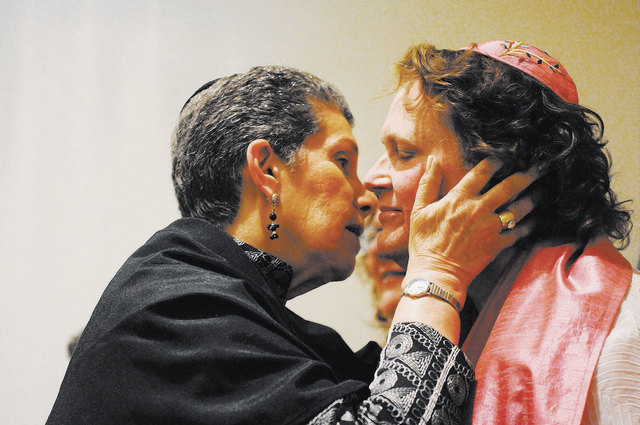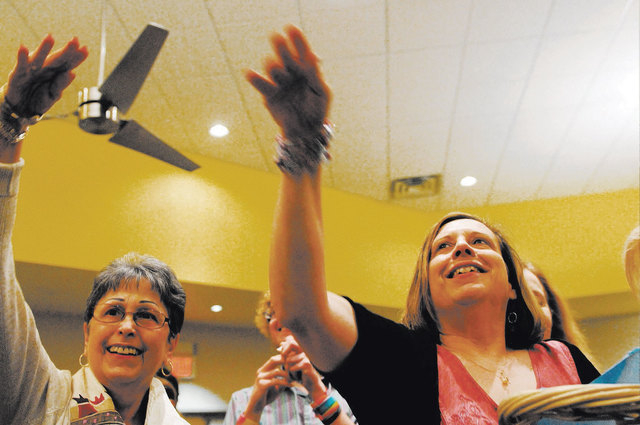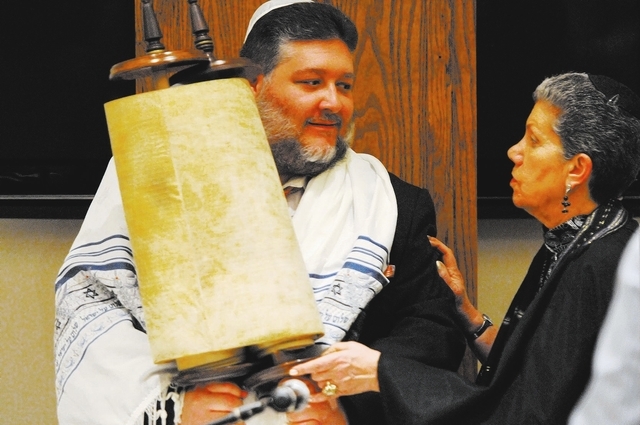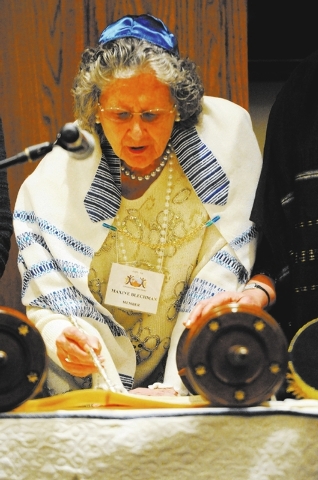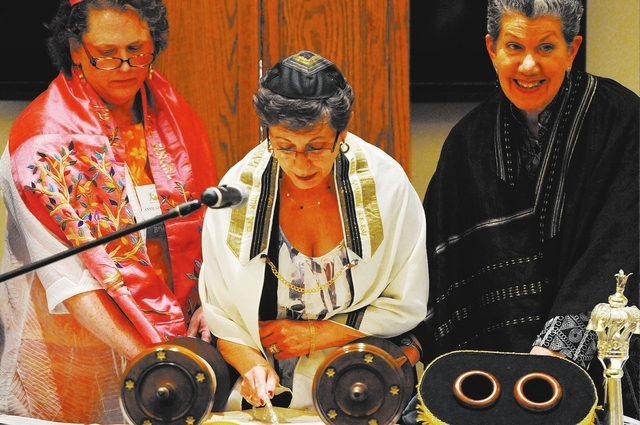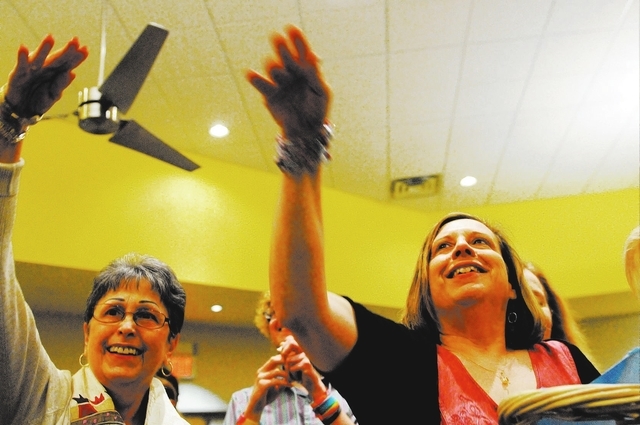Adults study long and hard to become B’nei Simchat Chochmah
It was a celebration filled with prayer, music, singing, blessings and, even handfuls of candy flung forward by members of the congregation.
But for eight adults who two weeks ago became B’nei Simchat Chochmah — literally, “descendants who rejoice in wisdom” — during Shabbat services at Congregation P’nai Tikvah, it was a ceremony filled with jitters over reading, for the first time and in public and in Hebrew, a passage of the Torah.
Not surprisingly, all went well, and when the moving and joyous service ended, the smiles on the students’ faces left no doubt that all of the linguistic preparation had been worth it.
Simchat Chochmah, or “the joy of wisdom,” is a relatively recent ritual, created in 1988, said Rabbi Yocheved Mintz of Congregation P’nai Tikvah. “It started out with women, and there are bits and pieces of this custom that have been picked up throughout the country, primarily in the Renewal movement (of Judaism).”
Although Simchat Chochmah bears some similarity to the bar mitzvah and bat mitzvah ceremonies many Jewish adolescents participate in at the age of 12 (girls) or 13 (boys), Mintz said Simchat Chochmah is a celebration of wisdom that honors adults’ journey from midlife into the elder years.
The eight adults ages 51 to 85 who became B’nei Simchat Chochmah two weeks ago represented the second class of B’nei Simchat Chochmah at Congregation P’nai Tikvah. To prepare for the ritual, the group participated in an intensive 18-month study of the liturgy, the Torah, and learning Hebrew in preparation for chanting the Torah at the service.
Only one student had become a bar mitzvah as a youth. Some were born into Judaism, a few converted into the faith as adults. And although the paths that led them to this particular point in their spiritual lives varied, all of the students said they simply felt a desire to learn more about their faith.
“I have a great love of Torah. I have a great love to hear it and be able to chant it,” said Nancey Eason, who was raised in the Episcopal church and converted to Judaism in 2006 when she was 43. “There’s something
that’s very meaningful and very profound in being able to look at something so ancient and be able to speak it.”
“All I can say,” Eason added, “is, it feels like home to me.”
Gloria Granat, 64, grew up in a Jewish household but said she “did not have that privilege” of becoming a bat mitzvah as a girl.
Then, when her son started to attend Hebrew school at the age of 3, “I started to become more and more involved in my religion,” Granat continued. “When I saw the pleasure he got out of learning and how he had such a love for learning the religion, I started to become interested in it as well.”
Still, it wasn’t until moving to Las Vegas about seven years ago and meeting Mintz that Granat said she had both the time to study and a rabbi with whom she wanted to study.
David Aris, 68, said his birth mother was a Holocaust survivor. According to Aris, when she gave him up for adoption, she specified that his adoptive parents not raise him Jewish.
His adoptive parents followed his birth mother’s wishes. Yet, Aris said, “from an early age, once I discovered that there was such a thing as ‘Jewish,’ I wanted to be Jewish.”
Several years ago, he began to seriously pursue his faith. “I decided that this is what I wanted,” Aris said. “I wanted the community. I wanted the participation. I wanted to be more than just saying, ‘Yeah, I’m Jewish.’ ”
So when the opportunity to become a B’nei Simchat Chochmah came, “I just jumped at the chance to participate in something that would deepen my understanding and deepen my faith and my involvement in the Jewish community,” he said.
Scott Linker, 60, became a bar mitzvah at the age of 13, and said studying the Torah as an adult moved him in a way it didn’t — or, perhaps, couldn’t — as a youth.
“The words have so much light and energy,” Linker said. “It’s such a deep spiritual dialogue when you approach it, for me, at a later age, whereas, before, I did it because everybody did it and I did it without question.”
The students said they found Hebrew a difficult language to learn. In addition to learning the language, when the time would come for them to chant the Torah during the Shabbat service, they would have to chant their passages in proper rhythm and with proper inflections.
“To be honest, I have two postgraduate degrees and it was harder to do this than getting my degrees,” Granat said.
Annie Goodrich Wolff, 51, said that, “for a long time, we were struggling to do it. At points, we all thought we weren’t going to be able to do it.”
Yet, for all of the difficulty, the students said reading Torah directly from a Torah scroll is a profoundly moving experience.
“You’re reading something ancient,” Eason said, adding that the Torah is “like layers of onions” in that “the more you open it, the more you discover and the more it can bring into your life.”
It’s much more powerful, Linker noted, than, say, reading the words of the Torah from a prayer book.
“I can only tell you how I feel,” he said, “but the prayer books, as wonderful as they are, it feels like a copy of a copy of a copy. This feels like God is writing just in front of you.”
Finally, at Shabbat services two weeks ago, the students put their year-and-a-half of study to work. Each chanted his or her passage from the Torah — and each of them very well, it turned out — then shared with the congregation his or her perspective on passages from the Book of Exodus.
Their reflections were heartfelt, incisive and even amusing. Aris, for example, likened God’s instructions for building the Tabernacle to instructions from Ikea, while Jennifer Cohen offered a few observations about the Hebrew word “Lev,” or “heart.”
Then, near the end of the service, congregants celebrated by singing and throwing hard candies at the B’nei Simchat Chochmah to wish them a sweet life.
Afterward, the students voiced relief that the public reading was over, but admitted that they would miss their weekly classes with one another. Their final session together, Eason said, was filled with “not melancholy, but ‘let’s make it last.’ ”
Linda Kauffman, 65, said becoming a B’nei Simchat Chochmah has given her “a sense of being able to study (the Torah). I’d have to say it just gives me a bigger insight of what the religion is all about and the meaning of it.”
Maxine Blechman, 85, said the process didn’t necessarily alter her perspective toward Judaism but, rather, “enhances it.”
And learning Hebrew? “It’s sort of like jumping rope,” Blechman said, “when you jump and all of a sudden you actually get over the rope and you know you’ve done it but you’re surprised, because all of a sudden, now you’ve done it.”
She smiles. “And it ain’t easy.”
Contact reporter John Przybys at jprzybys@reviewjournal.com or 702-383-0280.



